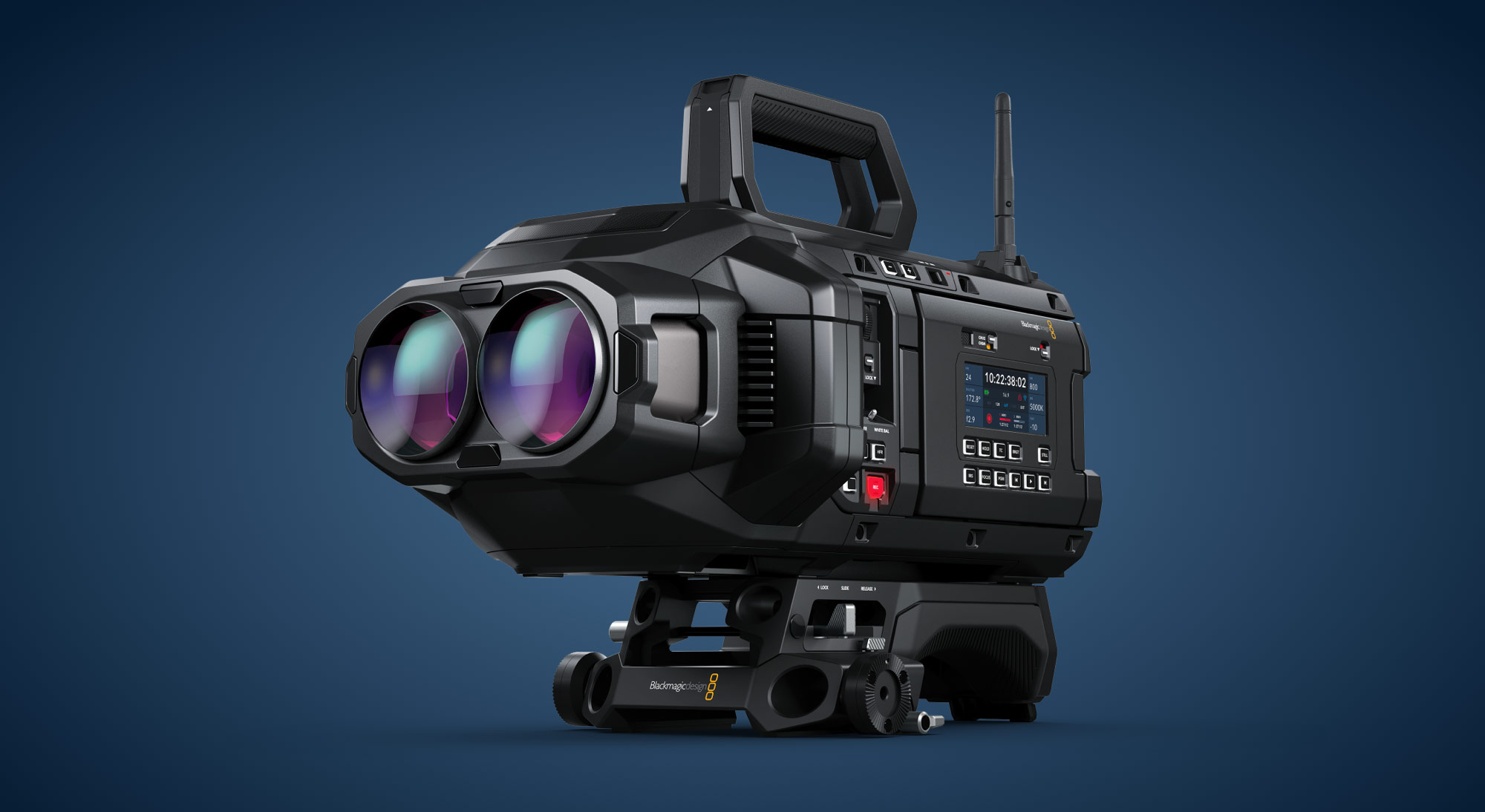Blackmagic Design Announces the World’s First Commercial Camera System and Editing Software for Apple Immersive Video on Apple Vision Pro
"We are thrilled to announce the first-ever commercial camera system and post-production software that supports Apple Immersive Video, giving professional filmmakers the tools to create remarkable stories with this powerful new format pioneered by Apple,"
- Grant Perry, BLackmagic Design CEO
Tim here with some exciting news! Blackmagic Design is releasing a new URSA camera called the URSA Cine Immersive that will be beyond 3D-Capable as it is designed specifcially for the Apple Vision Pro. This new camera isn't the only major announced release as they also announced developing a full end-to-end workflow with DaVinci Resolve to produce cinematic Apple Immersive Video on Vision Pro. This is very exciting new product and post workflow for creating content for the Apple Vision Pro, which is a great device for viewing Stereoscopic 3D content. Read all about it below in the official press release put out by Blackmagic Design:
Blackmagic Design today announced an end to end workflow for producing cinematic Apple Immersive Video for Apple Vision Pro. Blackmagic URSA Cine Immersive is the world’s first commercial camera system designed to capture Apple Immersive Video. Apple Immersive Video is a brand-new storytelling format that leverages 8K, 3D video with a 180-degree field of view, and Spatial Audio to transport viewers to the center of the action. Blackmagic Design also announced updates to DaVinci Resolve, the industry-leading post-production software, that will give professional filmmakers the ability to edit Apple Immersive Video for the first time. Blackmagic URSA Cine Immersive and a new version of DaVinci Resolve that supports Apple Immersive Video for Apple Vision Pro will be released later this year.
“We are thrilled to announce the first-ever commercial camera system and post-production software that supports Apple Immersive Video, giving professional filmmakers the tools to create remarkable stories with this powerful new format pioneered by Apple,” said Grant Petty, Blackmagic Design CEO. “Built on the new URSA Cine platform, URSA Cine Immersive features a fixed, custom, stereoscopic 3D lens system with dual 8K image sensors that can capture 16 stops of dynamic range. With this innovative system, filmmakers can record remarkable moments like action-packed scenes, unique perspectives, stunning landscapes, intimate performances, and more, all with incredible fidelity, offering viewers an unparalleled sense of realism and immersion.”
The World’s First Commercial Camera System for Apple Immersive Video
Blackmagic URSA Cine Immersive features a fixed, custom lens system pre-installed on the body, which is designed specifically for Apple Immersive Video. The sensor delivers 8160 x 7200 resolution per eye with pixel level synchronization and an incredible 16 stops of dynamic range, so cinematographers can shoot 90fps stereoscopic 3D immersive cinema content to a single file. The custom lens system is designed specifically for URSA Cine’s large format image sensor with extremely accurate positional data that’s read and stored at time of manufacturing. This immersive lens data — which is mapped, calibrated and stored per eye — then travels through post production in the Blackmagic RAW file itself.
The World’s First Editing Software for Apple Immersive Video
An updated version of DaVinci Resolve will introduce powerful new features to create a comprehensive workflow for immersive video on Apple Vision Pro. Blackmagic customers will be able to edit Apple Immersive Video shot on the URSA Cine Immersive camera. A new immersive video viewer will let editors pan, tilt and roll clips for viewing on 2D monitors or on Apple Vision Pro for an even more immersive editing experience. Transitions rendered by Apple Vision Pro will also be able to be bypassed using FCP XML metadata, giving editors clean master files. Export presets will enable quick output into a package which can be viewed directly on Apple Vision Pro.
URSA Cine Immersive is Designed to Meet the Demands of Any High End Production
The evenly weighted camera body is built with a robust magnesium alloy chassis and lightweight carbon fiber polycarbonate composite skin to help filmmakers move quickly on set. Customers also get 12G‑SDI out, 10G Ethernet, USB-C, XLR audio, and more. The fold out monitor has a large 5″ HDR touchscreen on one side and an external color status LCD on the other. The right side of the camera features a dedicated assist station with a second 5″ HDR touchscreen that allows crew to work around the camera without needing external monitors.
An 8-pin Lemo power connector at the back of the camera works with 24V and 12V power supplies, making it easy to use the camera with existing power supplies, batteries, and accessories. Blackmagic URSA Cine Immersive comes with a massive 250W power supply and B mount battery plate, so customers can use a wide range of high voltage batteries from manufacturers such as IDX, Blueshape, Core SWX, BEBOB, and more. Customers will also receive a top handle, antennas for high speed Wi-Fi, baseplate, 24V power supply and high voltage B mount battery plate for quick set up.
Blackmagic URSA Cine Immersive comes with 8TB of high performance network storage built in, which records directly to the included Blackmagic Media Module, and can be synced to Blackmagic Cloud and DaVinci Resolve media bins in real time. This means customers can capture over 2 hours of Blackmagic RAW in 8K stereoscopic 3D immersive, and editors can work on shots from remote locations worldwide as the shoot is happening.
The new Blackmagic RAW Immersive file format is designed to make it simple and easy to work with immersive video within the whole post production workflow, and includes support for Blackmagic global media sync. Blackmagic RAW files store camera metadata, lens data, white balance, digital slate information and custom LUTs to ensure consistency of image on set and through post production.
Blackmagic URSA Cine Immersive is the first commercial, digital film camera with ultra fast high capability Cloud Store technology built in. The high speed storage lets customers record at the highest resolutions and frame rates for hours and access their files directly over high speed 10G Ethernet. The camera also supports creating a small H.264 proxy file, in addition to the camera original media when recording. This means the small proxy file can be uploaded to Blackmagic Cloud in seconds, so media is available back at the studio in real time.
Blackmagic Media Dock accelerates post production workflow by making it faster and simpler to start editing and performing color correction. Customers can mount up to three Blackmagic Media Modules for high speed access to media from multiple URSA Cine Immersive cameras all at the same time. The four high speed 10G Ethernet ports allow up to four separate edit workstations to connect directly and is extremely fast, even when a lot of users are connected at the same time.
Blackmagic URSA Cine Immersive Features
- Dual custom lens system for shooting Apple Immersive Video for Apple Vision Pro.
- 8K stereoscopic 3D immersive image capture.
- 8160 x 7200 resolution per eye with pixel level synchronization.
- Massive 16 stops of dynamic range.
- Lightweight, robust camera body with industry standard connections.
- Generation 5 Color Science with new film curve.
- Dual 90 fps capture to a single Blackmagic RAW file.
- Includes high performance Blackmagic Media Module 8TB for recording.
- High speed Wi-Fi, 10G Ethernet or mobile data for network connections.
- Optional Blackmagic URSA Cine EVF.
- Includes DaVinci Resolve Studio for post production.
DaVinci Resolve Immersive Features
- Support for monitoring on Apple Vision Pro from the DaVinci Resolve timeline.
- Ability to edit Blackmagic RAW Immersive video shot on Blackmagic URSA Cine Immersive.
- Immersive video viewer for pan, tilt and roll.
- Automatic recognition of Apple Immersive Video (left and right eye) for dual file stereo immersive content.
- Option to bypass transitions rendered by Apple Vision Pro.
- Export and deliver native files for viewing on Apple Vision Pro.
Availability and Price
Blackmagic URSA Cine Immersive and the update to DaVinci Resolve will be available later this year from selected Blackmagic Design resellers worldwide.
About Blackmagic Design
Blackmagic Design creates the world’s highest quality video editing products, digital film cameras, color correctors, video converters, video monitoring, routers, live production switchers, disk recorders, waveform monitors and real time film scanners for the feature film, post production and television broadcast industries. Blackmagic Design’s DeckLink capture cards launched a revolution in quality and affordability in post production, while the company’s Emmy™ award winning DaVinci color correction products have dominated the television and film industry since 1984. Blackmagic Design continues ground breaking innovations including 6G-SDI and 12G-SDI products and stereoscopic 3D and Ultra HD workflows. Founded by world leading post production editors and engineers, Blackmagic Design has offices in the USA, UK, Japan, Singapore and Australia. For more information, please go to www.blackmagicdesign.com.
















